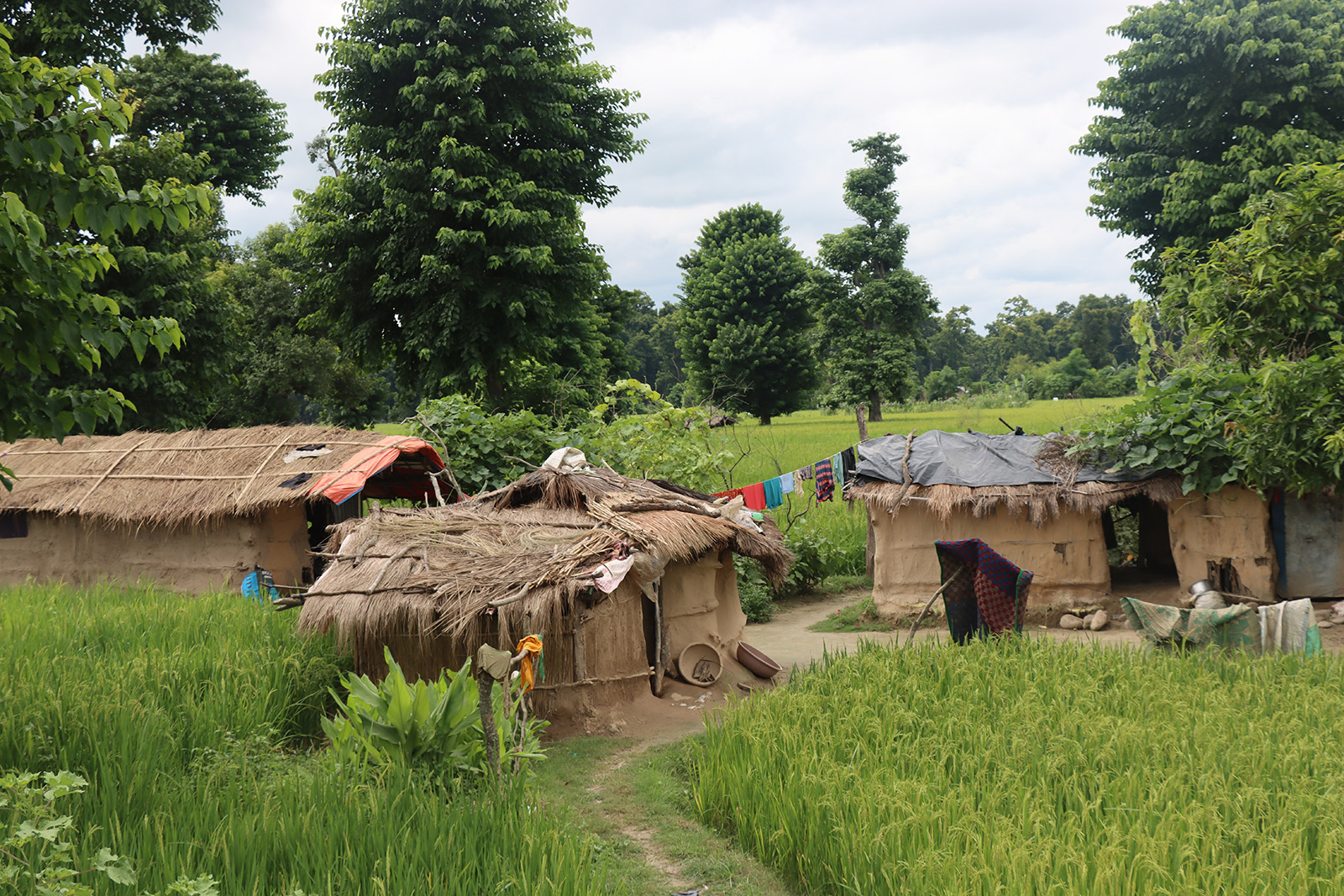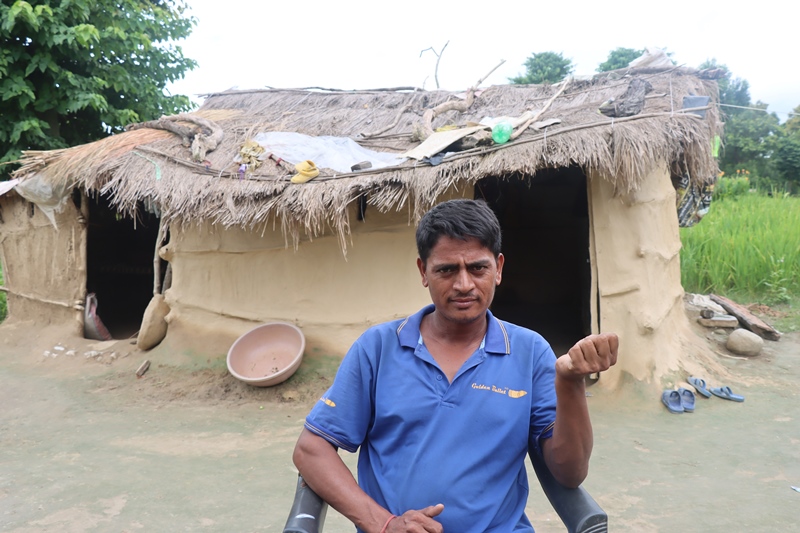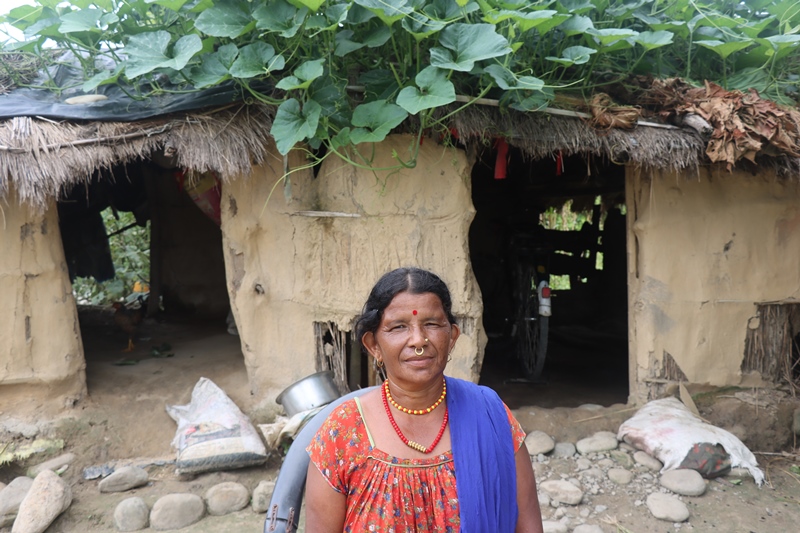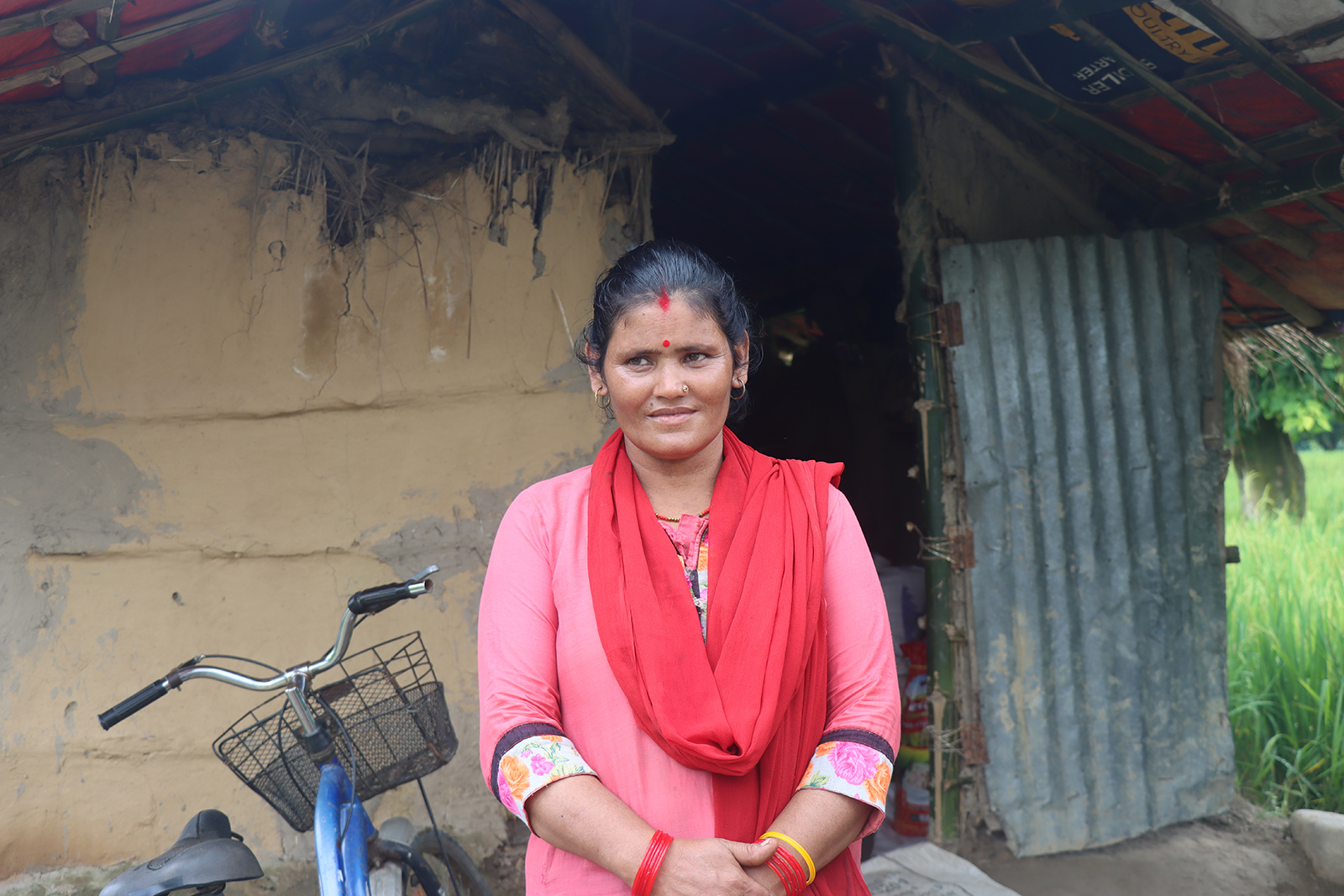Politicians visit the Dhakka camp during every election, vowing to end their plight, but the residents have given up all hope. This is the tale of the Kanchanpur “stateless” people who were evicted from their houses in order to create a national park.
Unnati Chaudhary |CIJ, Nepal
In the middle of the dense forest, amid the sprawling grasslands, stand a row of thatched huts that only the elderly and children call home. On winter nights, dewdrops leak from the roof of these structures devoid of doors. One can only imagine the situation during the rainy season! Although roads and electricity supplies are beyond the imagination of the people here, they don’t even have access to a reliable source of drinking water .
This is the ‘heart-wrenching’ story of the Dhakka camp and it is located in Kanchanpur District. Yes, that’s how it is known to the outside world.
In 1976, the government established the Shuklaphanta Wildlife Reserve (now Shuklaphanta National Park) on 155 sq km of land in western Nepal. Six years later, the reserve was expanded to incorporate an additional 150 sq km of land, where people had been living for generations.

Dhakka camp
The people were driven out of their homes, and the government decided to set up a committee to compensate the people with land deeds with land elsewhere. According to the decision, the government distributed land to the displaced between 1982 and 1986.
But 645 of the 2,373 families didn’t have title over the land they were living on and were forced to live in camps in Dhakka, Beldandi, Tarapur and Lallaredanda. The rest of the families lived around the forest area, says Gagan Khatri, facilitator at Samwad Samuha, an organisation advocating for the resolution of problems being faced by people displaced following the establishment of the protected area.
According to Khatri, people living in makeshift houses in Tarapur, Hatiya, Dhakka Chandeu, Lalpani, Bichwa, Andaiya, Pataiya, Hirapur and Bhatipur were again forced to flee the area during the Maoist insurgency. They set up 14 camps in and around the protected area. But on January 22, 2008, they were again driven out by the government. It was then that the people were forced to let go of their ancestral property and live in the huts in the Dhakka camp.
Settlement where people are used to pain
Dhakka camp resident Dev Bista (37) from the erstwhile Suklaphanta VDC-1, Sundarpur, says,“This is not a settlement, it is a bagful of maladies. The government loves animals more than people,” he added.
The situation of the camp is such that government agencies don’t know which municipality is responsible for providing local services to the 604 huts in the camp even after local representatives have already served a full five-year term in office. This shows that these people are truly ‘stateless.’

Dev Bista
There’s Shuklaphanta Municipality on one side of the settlement and Laljhadi Rural Municipality on the other. However, whenever residents go to one of the municipal offices seeking resolution to their problems, officials pass the buck on to the other municipality.
People from nine erstwhile VDCs now live in Dhakka. People living in Pipladi VDC-1 and 2, Rautelebichuwa VDC-1 and 6, Laxmipur VDC-7 and 9. Dekhatbhuli VDC-1 and 5 and Suda VDC-2, 6 and six were displaced from their houses when the wildlife reserve was set up.
The residents continue to cast their ballots in local elections based on their previous address, where they have nothing to call their own. But in the municipality where they live, the local government has disowned them.
As the residents don’t have documents to prove migration, they need to return to their previous addresses to complete government formalities and seek services.
Mayor of Shuklaphanta Municipality, Rana Bahadur Mahara, says that the Dhakka camp falls within the park area. “Dhakka camp is not geographically part of our territory, but some of our voters live there,” he says. “Therefore, in practical terms, we provide them services and facilities.”
Sapna Rana, vice-chair of Laljhadi Rural Municipality, insisted that the settlement should not fall under her municipality. She argued that since the residents of four municipalities live in the Dhakka camp, they go to their respective municipalities to seek services based on the address printed on their voter ID cards.
Due to this dispute of the municipalities, it has not been decided yet as to where the Dhakka camp belongs.

Residents of Dhakka Camp discussing their grievances.
Minister of Industries, Tourism, Forests and Environment of the Sudurpaschim Province Government Man Bahadur Dhami says that this dispute of Dhaka hasn’t been resolved because the provincial government hasn’t been authorised to deal with forest issues. He said that the provincial government formed a committee last July to look into the issue, and its recommendations will be implemented to solve the problem. However, residents of the camp are not satisfied with such an assurance.
Before Dev Bista came to the Dhakka camp, he possessed a bigha of Ailani land (0.691 acres) in Shuklaphanta VDC-9, Sundarpur. When they were removed from there, Dev and his neighbors were told that they would be given as much land as they had in Sunderpur. Houses of residents that didn’t want to leave their homes were even set on fire. Fifteen years have passed since that incident, but the promise has not been fulfilled.
Wild animals wreak havoc in the settlement in the middle of the forest. Wild animals such as boars destroy the crops. Last year, one person was killed by a wild elephant.
The main source of income for the residents here is animal husbandry as there’s no other means of livelihood. However, the park does not allow people to gather grass or firewood. According to Bista, the warden fines residents Rs 500 for illegal entry of humans and Rs500 of each cow, Rs 1,000 of each buffalo and Rs 50 for a goat.

Sita Rokaya
That’s not the end of their long list of the causes of their painful existence. It’s been 10 years since Rajendra, the husband of Sita Rokaya from Rautelbichuwa, went missing. Rajendra had left home one day after breakfast and has never returned.
Sita, in search of her husband, frequented the park and the adjoining forest. She also sent people to look for him in Mahendranagar and also in India. She even approached the district police office and the district administration office. She sought help from over the radio. However, her husband was nowhere to be found. “I took a loan of Rs 100,000 to look for my husband,” Sita says, “Afterwards, everyone said that your husband is dead, get a death certificate issued. However, the ward office did not provide the recommendation needed to get the death certificate issued.
After her husband disappeared, her son Bhim Bahadur was her support. Bhim Bahadur, who went to Delhi in search of work five years ago, is also missing.
“During the Covid-19 epidemic, widows here got relief from various associations, but I didn’t get it as I don’t have the municipality’s recommendations,” she said. “Ten years have passed waiting for my husband. If they give me a death certificate for my husband, I could get some help to at least survive.”

Kamala Bhandari
The husband of Kamala Bhandari of Dhakka camp is in India looking for work. To talk to her husband, she walks five kilometers and goes to the Chanddeu market to charge her mobile phone, which remains there all day. After her day’s work, she goes to the market to fetch the phone. “After doing this, I can finally talk to my husband on the phone. There is no way to earn enough to send the children to school without going to the market.
This June, the rain destroyed her hut, but she couldn’t even bring scrap wood from the park area to re-build it. “After a lot of hassles, I used bamboo to build a hut”, she said.
Although there are 14 camps of displaced people in Kanchanpur, Dhakka, Tarapur and Beldandi camps lie within the boundaries of the reserve. After neither the federal nor the local government listened to them, the residents of Dhakka launched their own children’s classes. A metal-roofed hut was built to run classes. According to Motilal Dagaura Tharu, a resident of the camp, a team from Shuklaphanta National Park came and removed the roof as they said it affects the deer’s vision. And the kindergarten classes were discontinued.
As the noise affects the animals, the residents are not allowed to use agricultural equipment such as tractors and threshers in the settlement. Dagaura says, “They don’t let us do any work. We are like prisoners in an open air prison.”
31 commissions in 42 years, what did they do?
It has been 42 years since the government formed the commission to solve the problems of those who were displaced during the expansion of the Shuklaphanta reserve. Sometimes it is called the commission to provide compensation to those displaced from the Shuklaphanta National Park, sometimes it is called a task force. Dal Bahadur Bohra is currently the chairman of the 31st Commission.
Before him, in March 2021, the 30th commission chaired by Surendra Bam spent its tenure collecting the victims’ records. The commission submitted a report to the government with the suggestion that compensation be provided to those displaced from the park. It said that at least around one acre of land or Rs 6 million in cash should be given as compensation to the victims each. Probably, the 31st commission will end its tenure by submitting a similar report.
Amritman Shrestha was appointed chairman of the first commission formed on January 16, 1981 when the then King Birendra visited the Shuklaphanta wildlife reserve. At that time, the commission, which received permission to distribute a total of land as compensation, estimated that 730 families were displaced and distributed land to some of them at the rate of around two acres per family. A year later, a second commission was set up under the name of High Level Commission for Forestry Strengthening, with Sarvagya Raj Pandit as its Chairman. Although it is said that the commission distributed compensation, no record of that time can be found.
After the restoration of democracy, encroachment started in the extended reserve area. As people started to migrate to Kanchanpur from the hilly districts, the land mafia and wood smugglers squandered the reserve’s forests.
Looking at the old documents, it appears that the commission chaired by Prem Bista compensated 466 families and even provided travel expenses in March 2000. Even though each family was given two thousand rupees to transport the belongings, security personnel couldn’t go to the encroached area due to the escalation of Maoist violence. As a result, even those who received compensation didn’t leave the place where they were living. Instead, more people migrated from the mountains to live on the reserve.
The tenure of Diwan Bista, the leader of the Nepali Congress, who became the chairman of the commission after the 2006/07 mass movement, ended as it prepared records. After him, the commission led by Mohan Giri of the Maoist party, Hira Sarki of the UML, Purna Bahadur Chand of RPP, Lal Bahadur Khadka of the UML, Pushkal Chaudhary of Madhesi Janadhikaar Forum, and Bir Bahadur Sunar of Nepali Congress spent their six-month tenures inspecting the camp.
In 2014, Thakur Prasad Sharma, a former judge of the Appellate Court, became the chairman of the 28th commission. The Sharma Commission, which also had a deadline of six months, classified 1,480 families into A, B and C categories.
The tenure of Sudhir Koirala, the chairman of the 29th commission who came after Sharma, ended without doing anything. Heera Singh Bhandari, chairman of the District Struggle Committee, says, “The government forms a commission and accepts its report. However, the recommendations aren’t implemented, and yet another commission is formed. It has now turned into never ending loop.”
Victims more victimized by politics
Dhakka camp has earned a reputation as a settlement set up by the Maoists. The then CPN-Maoist said that people living on vacant land would be allowed to live here until another arrangement was made.
Bir Bahadur Rajbanshi, the secretary of CPN Maoist Kanchanpur around 2008, admits that his party helped the displaced families live in the Dhakka camp. He said that his party helped families displaced without being given an alternative during the expansion of the reservation.

Heera Singh Bhandari
However, other squatters also came to this place under the guise of Maoists. The Maoists said that they would negotiate with the government and manage everything, which created a lot of inflow into the camp. Stating that great injustice has been done to those living there, Rajbanshi says, “Until now, they have been unable to feel that they are citizens.”
The Maoists, who helped establish this settlement, came to power many times, but its leaders did not do anything to resettle the people living in the Dhakka camp. Heera Singh Bhandari, president of the struggle committee, Kanchanpur, says that the problem has worsened as other parties don’t care about the camp that has earned a reputation for being Maoist.
Party workers and leaders come to this settlement only during elections. This year also, many leaders came, and promised to resettle everyone properly. “During the election campaign, everyone comes once or twice, they promise they will resolve the problem. However, they do not come back after the election”, says Bhandari.
Deepak Chandra Bhatta, assistant professor at Sudurpaschim University, says that the people displaced due to the Shuklaphanta reserve are treated as vote banks. He said that as most of the residents are Dalits, Tharu and members of the economically weak communities, the parties don’t care much about them..
“The parties only took advantage of their poverty and constraints, they never paid attention to their problems,” says Bhatt.
Bhandari says, “A commission is formed every month after we raise our problem. A commission spends between Rs 5 to 10 million. Members ride a car and blow dust, our dreams also fly away in the same dust.
So far, the 31 commissions have, on paper, distributed around 1,700 acres of land to families displaced by the reserve. During this period, they seem to have spent a large amount of money on office management, field allowances and transportation expenses. According to the details provided by the commission, around Rs 40-50 million is allocated for the commission annually.
The employees of the present commission say that they couldn’t find out how much the previous budget was as the old files were nowhere to be found.
Let’s have a look at the commission’s so far. The 28th commission formed under the chairmanship of former judge Thakur Prasad Sharma submitted a report to the government for re-examination of 1,480 of the 2,680 displaced families. However, even by the time of the 31st commission, the government doesn’t have the correct data on how many families were actually displaced by the reserve..
Chairman of the 31st commission, Dal Bahadur Bohra, says that the problem can’t be solved by a short-term commission formed for a short period. “I am the chair myself, but this is only a money making job. If you want to solve the problem, you should give it enough time to work”, he said.



